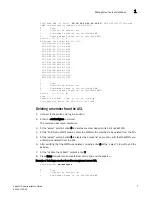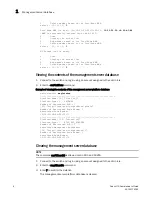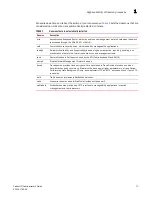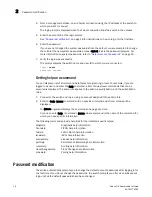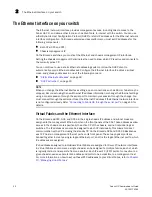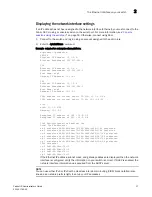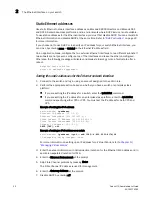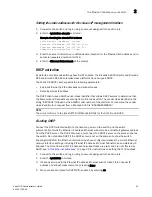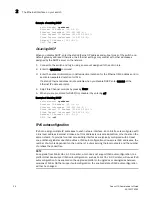
Fabric OS Administrator’s Guide
11
53-1001763-02
Device login
1
parameters do not match, a link will not occur. Once an SW_ACC frame is received from the
principal switch, the new switch sends an Exchange Switch Capabilities (ESC) frame. The two
switches exchange routing protocols and agree on a common routing protocol. An SW_ACC frame is
received from the principal switch and the new switch sends an Exchange Fabric Parameters (EFP)
frame to the principal switch, requesting principal switch priority and the domain ID list.
Buffer-to-buffer credits for the device and switch ports are exchanged in the SW_ACC command
sent to the device in response to the FLOGI.
Fabric login
A device performs a fabric login (FLOGI) to determine if a fabric is present. If a fabric is detected
then it exchanges service parameters with the fabric controller. A successful FLOGI sends back the
24-bit address for the device in the fabric. The device must issue and successfully complete a
FLOGI command before communicating with other devices in the fabric.
Because the device does not know its 24-bit address until after the FLOGI, the source ID (SID) in
the frame header making the FLOGI request will be zeros (0x000000).
Port login process
The steps in the port initialization process represent a protocol used to discover the type of device
connected and establish the port type and negotiate port speed.
The possible port types are as follows:
•
U_Port — A universal FC port is the base Fibre Channel port type, and all unidentified or
uninitiated ports are listed as U_Ports.
•
L_/FL_Port — A loop or fabric loop port connects loop devices. L_Ports are associated with
private loop devices and FL_Ports are associated with public loop devices.
•
G_Port — A generic port acts as a transition port for non-loop fabric-capable devices.
•
E_Port — An expansion port is assigned to ISL links to expand your fabric by connecting it to
other switches.
•
F_Port — A fabric port is assigned to fabric-capable devices, such as SAN storage devices.
•
EX_Port — A type of E_Port that connects a Fibre Channel router to an edge fabric. From the
point of view of a switch in an edge fabric, an EX_Port appears as a normal E_Port. It follows
applicable Fibre Channel standards as other E_Ports. However, the router terminates EX_Ports
rather than allowing different fabrics to merge as would happen on a switch with regular
E_Ports.
•
Mirror Port — A mirror port is a configured switch port that connects to a port to mirror a
specific source port and destination port traffic passing though any switch port. This is only
supported between F_Ports.
•
VE_Port — A virtual E_Port is a gigabit Ethernet switch port configured for an FCIP tunnel.
However, with a VEX_Port at the other end, it does not propagate fabric services or routing
topology information from one edge fabric to another.
•
VEX_Port — A virtual EX_Port connects a Fibre Channel router to an edge fabric. From the point
of view of a switch in an edge fabric, a VEX_Port appears as a normal VE_Port. It follows the
same Fibre Channel protocol as other VE_Ports. However, the router terminates VEX_Ports
rather than allowing different fabrics to merge as would happen on a switch with regular
VE_Ports.
Содержание 53-1001763-02
Страница 1: ...53 1001763 02 13 September 2010 Fabric OS Administrator s Guide Supporting Fabric OS v6 4 0 ...
Страница 4: ...iv Fabric OS Administrator s Guide 53 1001763 02 ...
Страница 24: ...xxiv Fabric OS Administrator s Guide 53 1001763 02 ...
Страница 28: ...xxviii Fabric OS Administrator s Guide 53 1001763 02 ...
Страница 32: ...xxxii Fabric OS Administrator s Guide 53 1001763 02 ...
Страница 40: ...xl Fabric OS Administrator s Guide 53 1001763 02 ...
Страница 42: ...2 Fabric OS Administrator s Guide 53 1001763 02 ...
Страница 54: ...14 Fabric OS Administrator s Guide 53 1001763 02 High availability of daemon processes 1 ...
Страница 74: ...34 Fabric OS Administrator s Guide 53 1001763 02 Basic connections 2 ...
Страница 102: ...62 Fabric OS Administrator s Guide 53 1001763 02 Audit log configuration 3 ...
Страница 156: ...116 Fabric OS Administrator s Guide 53 1001763 02 The authentication model using RADIUS and LDAP 5 ...
Страница 214: ...174 Fabric OS Administrator s Guide 53 1001763 02 Management interface security 7 ...
Страница 228: ...188 Fabric OS Administrator s Guide 53 1001763 02 Brocade configuration form 8 ...
Страница 276: ...236 Fabric OS Administrator s Guide 53 1001763 02 Creating a logical fabric using XISLs 10 ...
Страница 404: ...364 Fabric OS Administrator s Guide 53 1001763 02 ...
Страница 440: ...400 Fabric OS Administrator s Guide 53 1001763 02 Performance data collection 17 ...
Страница 464: ...424 Fabric OS Administrator s Guide 53 1001763 02 Disabling bottleneck detection on a switch 18 ...
Страница 480: ...440 Fabric OS Administrator s Guide 53 1001763 02 F_Port masterless trunking 19 ...
Страница 494: ...454 Fabric OS Administrator s Guide 53 1001763 02 Buffer credit recovery 20 ...
Страница 560: ...520 Fabric OS Administrator s Guide 53 1001763 02 Port indexing on the Brocade DCX 4S backbone C ...
Страница 574: ...534 Fabric OS Administrator s Guide 53 1001763 02 Hexadecimal overview E ...











